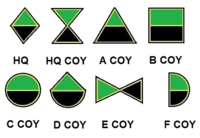2 South African Infantry Battalion
| 2 South African Infantry Battalion | |
|---|---|

SANDF 2 SAI emblem
|
|
| Active | 1 January 1962 to present |
| Country |
|
| Branch |
|
| Type | Motorised infantry |
| Part of | South African Infantry Formation |
| Garrison/HQ | Walvis Bay previous Zeerust |
| Motto(s) | In Utrumque Paratus (Prepared for all situations) |
| Engagements | South African Border War |
| Battle honours | Angola 1975 |
| Insignia | |
| Company level Inisgnia |  |
| SA Motorised Infantry beret bar circa 1992 | |
2 South African Infantry Battalion is a motorised infantry unit of the South African Army.
2 SAI was established on January 1, 1962, at Walvis Bay, South-West Africa (Namibia). The first officer to command the battalion was Major GN Mcloughlin and the first RSM was WO1 JAJ Steenkamp. Initially the base consisted of tents, but was later replaced by prefabricated buildings. Basic training took place in the desert and running up Dune 7 became part of that regime.
While at Walvis Bay, 2 SAI was organised as a battlegroup when an armoured car subunit, D Squadron, and an artillery battery, 43 Field Battery, was added. This accounts for the unit insignia including at the top the number "2" in infantry colours, with the St Barbara's lighting flash representing the artillery in the middle and armour's old heraldic colours at the bottom.
These elements and the Transport Park and quartermaster were based at Rooikop, a distance inland because of the rust at the coast. The unit was awarded its colours by the local municipality in 1969, and adopted the town’s motto and flamingo emblem as a consequence.
The unit first saw deployment to the South-West Africa/Angola border in 1968. The unit took part in Operation Savannah during 1975, when South African troops covertly involved themselves in the Angolan Civil War. The unit disbanded at the end of 1989 when Namibia gained independence.
On the 1 July 1993, the unit was reformed at Pomfret from old members of 32 Battalion, it then resorted under Northern Cape Command.
By 1998, the unit was transferred to North West Command and then based in Zeerust.
On its reactiavtion back in South Africa, 2 SAI was transformed into a motorised infantry unit using mostly Samil trucks, Mamba APC’s or other un-protected motor vehicles. Samil 20, 50 and 100 trucks transport soldiers, towing guns, and carrying equipment and supplies. Samil trucks are all-wheel drive, in order to have vehicles that function reliably in extremes of weather and terrain. Motorised Infantry have an advantage in mobility allowing them to move to critical sectors of the battlefield faster, allowing better response to enemy movements, as well as the ability to outmaneuver the enemy.
...
Wikipedia

